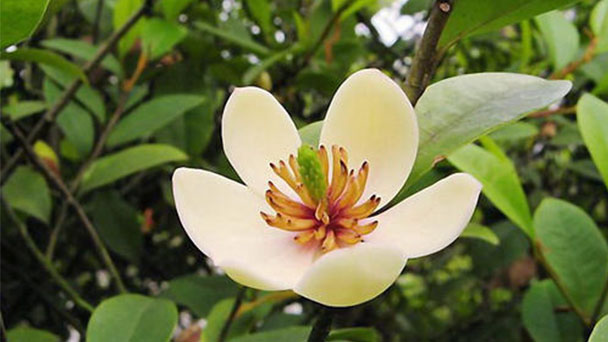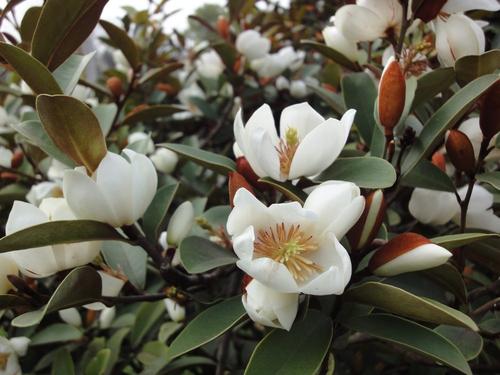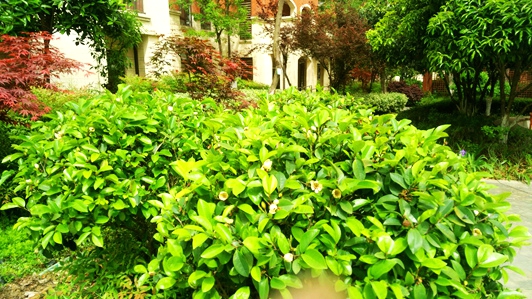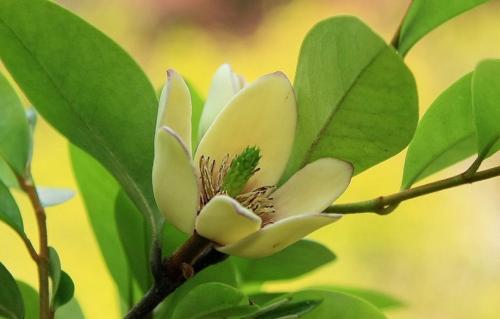Michelia Figo Profile
Written by LisaSmith
Sep 27 2021

Michelia Figo or Port wine Magnolia is a flower and foliage plant that we are familiar with and love. It is often planted in the courtyard or potted in the living room. When Michelia Figo blooms, the floral fragrance scents in the wind, and the buds are white like jade. It is one of the famous fragrant flowers. Let's get to know Michelia Figo in detail.
Michelia Figo Picture

Michelia Figo Characteristics
Evergreen shrub, 2-3 meters high, gray-brown bark, densely branched; buds, tender branches.
Petioles and pedicels are densely covered with yellowish brown hairs. The leaf is leathery, narrowly elliptic or obovate-elliptic, 4-10 cm long, 1.8-4.5 cm wide, apex is obtuse and short-pointed, base is wedge-shaped or broad-wedge-shaped, shiny and glabrous, with brown flat hairs on the lower midrib , I shed hairless, the petiole is 2-4 mm long, and the stipule mark is as long as the top of the petiole.
Michelia Figo flowers stand upright, petals 12-20 mm long, 6-11 mm wide, light yellow with edges sometimes red or purple, with sweet and strong fragrance, tepals 6, fleshy, plump, oblong, 12- 20 mm, 6-11 mm wide; stamens are 7-8 mm long, and the drug septum protrudes into sharp tips, the pistil group is glabrous, about 7 mm long, and exceeds the stamen group; the pistil group is about 6 mm long and pale Yellow fluff. michelia figo blooms from March to May and fruit from July to August.
Michelia Figo growing environment
Michelia Figo was born in a mixed forest on a shady slope, especially along the valley. michelia Figo likes fat and half-shade. It grows best in weak shade. Avoid strong direct sunlight. Pay attention to shade in summer. Move to the greenhouse before the frost at the end of autumn and live through the winter at a temperature of about 10°C.
Michelia Figo is a warm woody flowering shrub, not very hardy, and can live through the winter openly in the south of the Yangtze River leeward to the sun. Not tolerant to dryness and barrenness, but also afraid of stagnant water, it requires good drainage, fertile slightly acidic loam, and neutral soil can also adapt.
Michelia Figo Propagation
Michelia Figo can be propagated by cutting, circle branch propagation and grafting methods.
The Michelia Figo cutting propagation method should be done from late July to early September. The lignified branches or apical buds that still have no new buds but leave 3-8 leaves are about 15 cm in length, and the roots are attached to the base of the cuttings. On sandy soil, provide appropriate shade and keep the environment moist. It will take about 2 to 3 months to take root, and then transplant it in the following spring.

For Michelia Figo branch propagation, select 2-year-old branches that are well-developed, well-organized and robust in April. Make a 0.5cm wide girdling on the appropriate part of the branch, reaching the xylem, apply moist bryophytes to the girdling part, wrap it with plastic film, tie it up and down tightly, and take root in about 2 months. After the new roots are fully developed, cut the upper pot for cultivation, water thoroughly after cultivation, and then water once a day or not. Start fertilizing when the new shoots are about 7cm long.
Michelia Figo Care
Watering Michelia Figo
Always keep the pot soil moist, but never too wet. Because the roots of Michelia Figo are very fleshy, they will become rotten roots if watered too much or after the rain is flooded. Therefore, the humidity should be controlled during the rainy season. More water is needed during the growth period and before flowering, watering once a day, and watering the leaves in hot weather in summer to maintain a certain air humidity. In autumn and winter, watering can be done once or twice a week due to the short sunlight.
Fertilize Michelia Figo
Michelia Figo loves fertilizer. Fertilizer is applied every 15 days during the growing season (April to September). Fertilization is stopped after the flowering period and after October. If you find that the leaves are not bright and dark green, you can apply Gongfei water once.
Prune Michelia Figo
Michelia Figo should not be over-pruned. It is usually possible to prune the elongated branches, diseased branches, and overly dense overlapping branches that affect the shape of the tree after flowering, and subtract the fruits after flowering to reduce nutrient consumption. Before budding in spring, remove some old leaves appropriately to trigger new branches and leaves.
Repot Michelia Figo
Repotting should be done every 1 to 2 years, preferably before new leaves are released in spring, or after Michelia Figo blooms, or in autumn. Combining with changing the basin to remove the appropriate part of the old hardened soil, replace it with fertile and loose cultivated soil, minus dead branches and excessive elder roots, and place sufficient base fertilizer in the basin.
Michelia Figo Winter Care
The northern potted Michelia Figo needs to be overwintered indoors, and its maintenance has the following points.
1. Temperature: The minimum temperature for Michelia Figo overwintering is not less than 5℃. Once the temperature is lower than 5℃, the normal physiological activities of the plant will be affected, the absorption capacity of the root will be weakened, and the tender branches and leaves of the plant will wilt. At the same time, the maximum temperature should not exceed 15°C. If the temperature is too high, the plant's internal nutrients will be consumed too much, which will be detrimental to the next year's growth. Therefore, it is advisable to keep the room temperature at 5℃ to 15℃ in winter.
2. Humidity: smiley likes a humid environment, dry air is not good for its growth. In winter, the relative humidity is generally required to be above 65%. When the air is dry, spray the ground and plant leaves with a sprayer to increase the air humidity, but the temperature of the sprayed water should not be too different from the room temperature, and cold water should not be used.
3. Watering: Michelia root is a fleshy root, so too much watering in winter will cause root rot or cause pests and diseases. Generally, water once a week. Before watering, make sure that the water temperature, room temperature, and soil temperature are almost the same. The watering time should be selected when the temperature is high at noon. It is not suitable to water in the morning and evening when the temperature is low, so as to avoid sudden temperature changes and frostbite the roots.
4. Ventilation: After putting Michelia Figo in the room, keep the indoor air fresh. If the ventilation is not good, it is easy to be harmed by aphids, scale insects and other pests. If it is placed in a greenhouse with coal for heating in winter, a large amount of harmful gases such as carbon monoxide and sulfur dioxide will poison the plants. Therefore, open windows for ventilation and light transmission at noon on a sunny day without wind.
5. Fertilization: Michelia Figo is in a dormant or semi-dormant state in winter, and the amount of fertilizer required is not large. A base fertilizer based on organic fertilizer should be properly applied to facilitate Michelia Figo to bloom in the coming year.
Michelia Figo Disease Control
Common diseases of Michelia Figo include leaf blight, anthracnose, algae spot, and coal pollution. These diseases all harm the leaves and are not conducive to the growth of Michelia Figo. When a disease occurs, the diseased leaves should be removed and burned immediately, and then the corresponding agent should be sprayed to prevent spread. To prevent leaf blight, spray 0.3% lime-sulfur mixture every 15 days or so in early spring; after the onset of disease, use 500-600 times liquid of 65% dysenzine wettable powder for spray control. To prevent anthracnose and algae spot disease, we must first strengthen the management of fertilizer and water, prevent algae spot disease, and appropriately increase the application of phosphorus and potassium fertilizers to make the plants grow stronger and improve the resistance to pests. 0.5% Bordeaux mixture or 600-750 times liquid spray of 5% Baiyinqing WP, spray once every 10 days. In the prevention and control of coal pollution, when cleaning the sick leaves, the first is to eliminate the insects. When the pests and diseases are relatively light, it can be washed with clean water and pay attention to proper ventilation and light transmission. When the Michelia Figo disease is serious, use 800-1000 times liquid spray of 50% Tuejunte wettable powder for prevention and control, spray once every 10 days, spray 2-3 times.

The main diseases of Michelia Figo are black mold and yellowing disease. It can be sprayed with 0.5 degree Bordeaux mixture or scrubbed with 5% alcohol; spray with 0.1% to 0.2% ferrous sulfate solution to prevent yellowing disease. The main pests are scale insects, aphids and red spiders, etc., which can be sprayed with 80% dichlorvos 1000 to 1500 times liquid.
When controlling, first cut the dense branches of Michelia Figo appropriately to make the tree ventilated and light. When the pest is relatively light, it can be manually removed with a brush; during the nymph hatching period, it can be killed by spraying with 40% omethoate EC 2000 times.
Latest Updated
- Benefits of Bugleweed - 7 Science-backed Health Benefits
- Bugleweed Dangers & Side Effects - Is It Poisonous?
- How to Plant Evergreen Trees - What You Should Know
- When to Plant Evergreens - Grow Guide for Evergreen Trees
- 12 Wonderful Evergreen Shrubs for Your Garden
- 12 Popular Evergreen Plants with Pictures for Beginners
- When And How To Prune A Lilac Bush Like a Pro
- How to Grow & Care for Lilac Vine (Hardenbergia Violacea)
- Japanese Lilac Tree (Syringa Reticulata) Care & Propagation Guide
- Shumard Oak Pros and Cons - What to Know
Popular Articles
- Winter maintenance of Antirrhinum Majus
- How to Grow Terminalia Mantaly Tree
- How to Grow and Care for Crossostephium Chinense
- How to grow Antirrhinum Majus in spring
- Peristeria Elata (Dove Orchid) Profile: Info & Care Guide
- Underwatered Snake Plant (Sansevieria Trifasciata) - Signs And How To Fix
- How to Care for Brazilian Jasmine Plant (Mandevilla Sanderi)
- How to Grow & Care for Graptopetalum Purple Delight in Summer
- Rosa Chinensis (China Rose): Plant Growing & Care Tips
- How to Care for Baby Sun Rose (Aptenia Cordifolia)